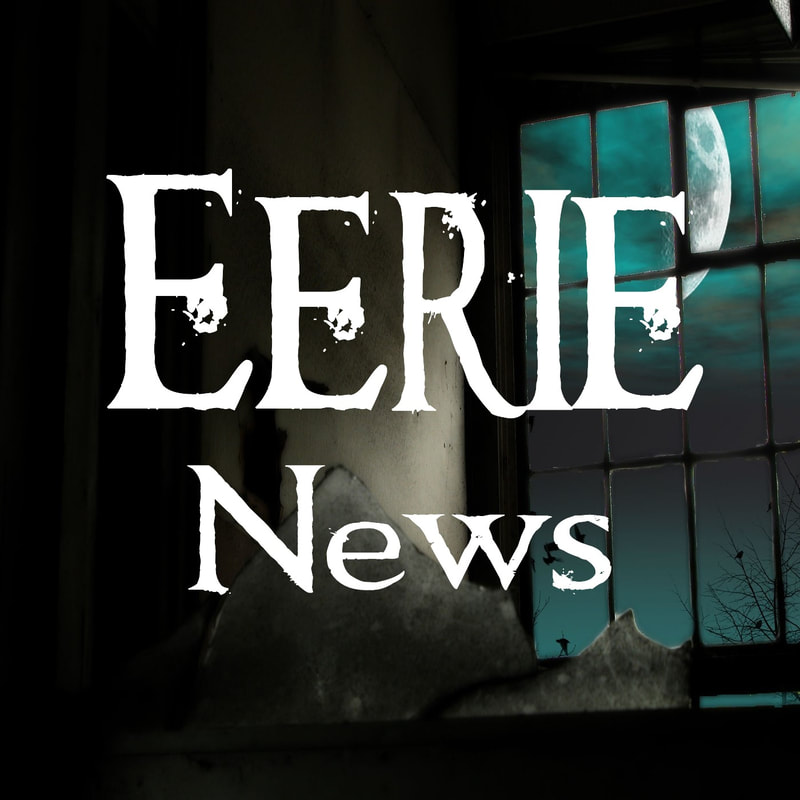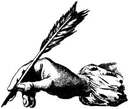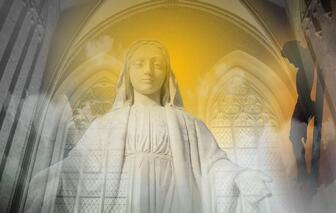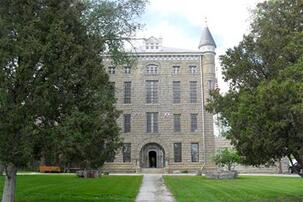 By M.P. Pellicer | Stranger Than Fiction Stories Wyoming Frontier Prison is known as The Old Pen, with a reputation of being the most haunted prison in the state. Of all the inmates that were held there, one of the most grisly and psychopathic was Andrew Pixley who was executed in the gas chamber in 1965. It's claimed he's not moved on from where he met his demise and justice was served. However the area is rich in a history of bloodthirsty outlaws. 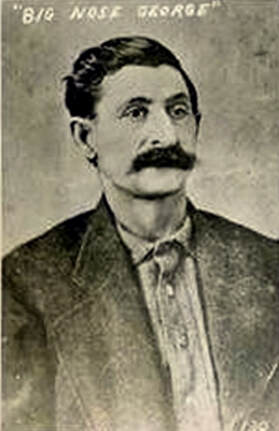 Big Nose George Parrott was lynched in 1881 for his crimes including the murder of 2 deputies Big Nose George Parrott was lynched in 1881 for his crimes including the murder of 2 deputies In 1872, desperadoes caught breaking the law in Wyoming were sent to serve their sentence at the Wyoming Territorial Prison, which opened in 1872 as a U.S. Penitentiary on 190 acres. Later it became Wyoming's first State Penitentiary. For the next 30 years it was known as the "Big House Across the River". Serving time in the prison was harsh, but by comparison to what happened to some outlaws it was preferable. Such is the story of the fate of Big Nose George. In December 1880, George Parrot (AKA Parrott, George Francis Warden) a Frenchman who went by the alias of Big Nose George or George Au-Gros-Nez, was a notorious road agent and murderer, who received an invite for a necktie party scheduled for April 2, 1881. The most egregious of his crimes was the killing of two deputy sheriffs. In August, 1880, Sheriff Rankin from Carbon County had arrested George at Miles City. He was a member of a gang of train robbers, who on August 13, 1878 killed two deputy sheriffs named Robert Widdowfield, and Henry "Tip" Vincents at Elk Mountain, Wyoming. The deputies were in pursuit of the gang at the time, and were ambushed and murdered by the outlaws. The sentiment of the citizens of Carbon, where the men were known as highly respected citizens, was strongly against the perpetrators. 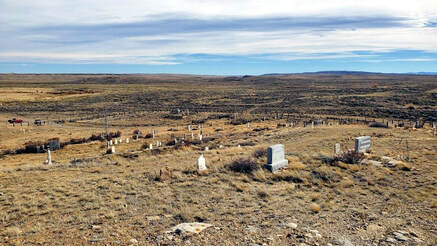 Carbon Cemetery, Carbon County, WY, present day (source - FindaGrave) Carbon Cemetery, Carbon County, WY, present day (source - FindaGrave) Shortly after the murder, Charles Bates (Burress) alias Dutch Charley was captured enroute from Laramie to Rawlins, where he was taken from the train at Carbon by a number of masked men. He was hanged at a telegraph pole. The act was condemned by the citizenry, but the newspapers noted it was richly deserved. Sheriff Rankin warned by what had happened to Dutch Charley two years before, kept a sharp eye out when he was near Carbon, since he feared Big Nose George would suffer the same fate. His sole purpose was to get his prisoner to stand trial for his crimes in a court of law. However the friends of Widdowfield and Vincents "got in their work", and were waiting for an opportunity to accomplish their mission. Rankin took the precaution of giving the keys to the prisoner's shackles and handcuffs to G.C. Smith, the prosecutor from Carbon County who was on the train as well. They rolled into town after nightfall, when without warning the car was filled with masked and armed men. 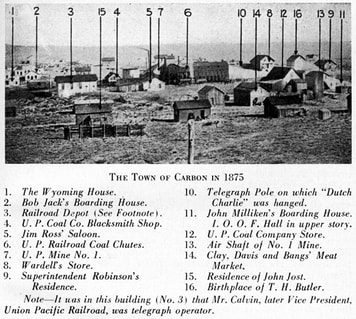 Layout of Carbon, WY c.1875 (source - WYOHistory.org) Layout of Carbon, WY c.1875 (source - WYOHistory.org) The sheriff was disarmed and he was searched for the keys. Big Nose George who saw what was happening, snatched a revolver from the hands of one of the men who had him, but he was overpowered. Without the keys, a sledge hammer was used to crush the shackles, and the masked men dragged Big Nose George out of the car to a nearby corral. He was hoisted up until he confessed to everything, including that he was part of the gang who killed the deputies along with Dutch Charley. He was taken back to the train and delivered to the sheriff. One of the train passengers was an English nobleman, who said while the sheriff was being held down: "Mr. Sheriff, I sympathize with you; indeed I do." "Shut up, you (expletive)," one of the masked guarded responded and a revolver was thrust into his face. "I beg pardon, gentlemen, I only wanted to sympathize with the sheriff." He then retired hastily. The masked men had planned well, holding the engineer and fireman while another held the conductor inside the express car. The train was delayed about 30 minutes. Memories were long in those times and in these parts. While Big Nose George was being held in a jail cell, it was remembered there were stage robberies on the Cheyenne and Deadwood stage road. Boone May, a messenger on the line had killed Frank Toole. It was said by those who knew the truth of the matter that Toole was with the Elk Mountain gang, when the two deputies were killed. The gangs had made various attempts to wreck passenger trains on the Union Pacific railroad, and a reward of $2,000 was offered by Carbon county for their capture dead or alive, and guaranteed by the railroad. Once Big Nose George verified that Toole had been part of the gang, Boone received the reward. 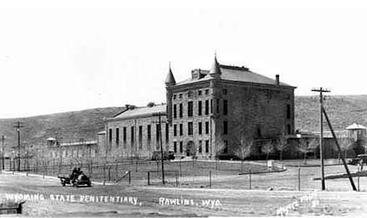 Wyoming State Pen., Rawlins, WY c. early 1900s Wyoming State Pen., Rawlins, WY c. early 1900s This original gang had formed in the Powder River country, and included Big Nose George, Joe Manuse, Frank McKinney, Jack Campbell, Sim Jan, John Wells a.k.a. Sandy, Tom Reed, Frank Toole and Dutch "Charley" Bates. Prior to his trial in 1880, Big Nose George said that McKinney claimed to be Frank James, and that Sim Jan was the leader of the gang. This led to speculation that Frank and Sim were actually Frank and Jesse James. It probably was not true, McKinney was most likely "Reddy" McKimie. Fast forward to the spring of 1881, and even though George Parrot was slated to be executed in April, on March 23, masked men stormed the jail at night where he was being held. He was strung up to a telegraph pole opposite the railroad machine shops. He asked to be shot, but instead they hung him, while he choked to death instead of breaking his neck. His was left hanging on the telegraph pole until the coroner could reach Carbon the next day. In August, 1881 Governor Morgan received a letter from the Consulat-General of France, on behalf of George Parrot's widow asking for a certificate of his death. Apparently his origins were French. 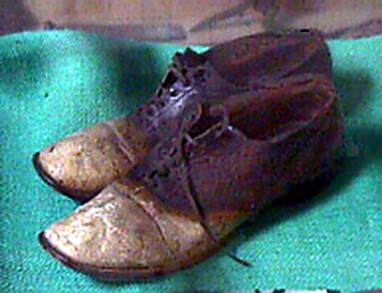 Shoes made from Big Nose George Shoes made from Big Nose George Being the most hated man in town, the populace decided to add insult to injury and instead of burying George, they donated his body to the local physician. Dr. Osborne wanted to "discover" whether the outlaw's skull and brain (phrenology) was different from non-criminals. He made a death mask of George, then skinned and dismembered the body. He sawed off the top of the skull, which he gave to Dr. Lillian Heath, wife of Lou Nelson of Rawlins. The skin was sent to a tanner, and a portion from his thighs was made into a pair of shoes. The chest skin was made into a medicine bag. Eventually Dr. Osborne immersed the skull and other bones in a saline solution in a whiskey barrel, which he buried in the yard of his office. Dr. Osborne not only practiced medicine, but became the largest individual sheep owner in the Territory. He was also Board Chairman of the Rawlins National Bank, and he served in the Territorial State and National offices. He served as mayor of Rawlins and then as Governor of Wyoming, after the first governor Francis E. Warren resigned to serve in the Senate. Osborne died on April 24, 1943. In May 1950, some workmen digging an excavation for a store building on West Cedar Street, unearthed a large barrel. Inside were the grim remains of George Parrot. There were human bones including a skull with its top sawed off, along with shoes with glass nails and a bottle of vegetable compound. By 1899, the small town of Carbon was bypassed by the railroad after they reconstructed their route to Nebraska. By 1902, the mines at Carbon had closed and the town was gradually abandoned with the last persons leaving around 1912. As a typical ghost town, present day the roads, mine ruins, the roadbed for the Union Pacific Railroad and foundations are all that's left of Carbon. 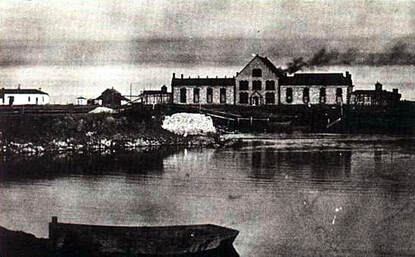 Laramie River in front of Wyoming Territorial Prison c.1895 Laramie River in front of Wyoming Territorial Prison c.1895 In the process of Carbon being abandoned, the Wyoming Territorial Prison closed its doors in 1903, after three decades of housing outlaws and desperados. This is when the Wyoming Frontier Prison opened its doors. Eventually this prison became known as The Old Pen. Despite its new construction, the 104 cells had no running electricity or water. For many years the average temperature was 20 degrees Fahrenheit. Violent offenders, many who were slated to die by hanging or in the gas chamber, were housed here before their final departure from this world. A total of 14 were executed at the prison; nine by hanging and five in the gas chamber. It held women until 1909, then afterward female prisoners were shipped to Colorado. It closed its doors in 1980, and opened as a museum in 1988, becoming a favorite destination for ghost tourism. Employees and tourists describe feelings of being watched with hostile eyes. For some visitors the feeling has chased them out of the building. Many believe it's the ghost of a young drifter who committed a heinous crime. 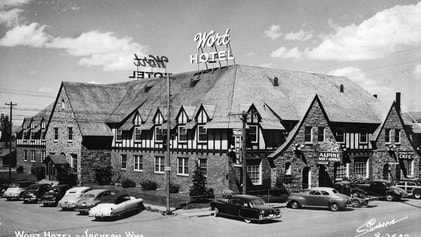 Wort Hotel, Jackson, Wyoming c.1950s to 1960s Wort Hotel, Jackson, Wyoming c.1950s to 1960s Andrew Pixley was a 21-year-old dropout who drifted to Wyoming from Oregon. He served 18 months in the army mostly overseas. He drifted around, and got a job as a dishwasher at The Wort Hotel in Jackson. He lived in a trailer with two hotel employees, David Starling and Orval Edwards. Starling was said to have had prior knowledge of Pixley's violent disposition, even though the young man had been working there only two weeks. On the night of August 7, 1964 Pixley stacked a woodpile against the back wall of the hotel, took off his shoes and climbed onto a thin ledge. He opened a screen to a room on the second floor, which was occupied by Debbie McAuliffe, 12, and her sisters Cindy, 8, and Susan, 6. Judge Robert McAuliffe and his wife, the girl's parents were spending time at the hotel lounge, but when management told them there were noises coming from inside the room, they returned and opened the door and found their worse nightmare had become reality. Debbie was beaten to death and lying on her bed, Cindy was strangled and a slim man was lying shirtless on the floor of their room covered in their daughters' blood. Both girls were sexually assaulted, and Susan was saved by the arrival of her parents. Debbie had been bludgeoned with a rock, and Cindy was beaten and strangled. 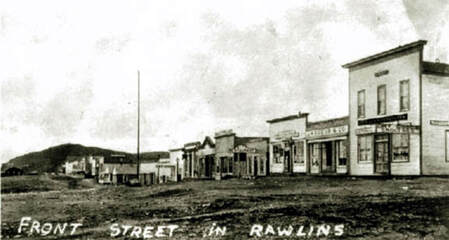 Front Street, Rawlins at intersection with Third Street as viewed from the grounds of the Union Pacific passenger depot. The fourth building houses the U P Restaurant. The scene was the location of the hanging of Big Nose Parrott in 1881, c.1884 Front Street, Rawlins at intersection with Third Street as viewed from the grounds of the Union Pacific passenger depot. The fourth building houses the U P Restaurant. The scene was the location of the hanging of Big Nose Parrott in 1881, c.1884 The father seized the stranger, and a crowd soon gathered drawn by his wife's screams. The police arrived as a mob called out for a lynching. Andrew Pixley, real name Armando Benevidez, claimed that from the time of his arrest until his execution he had no memory of what he had done to the girls. Later he said, "If I did something like that, I deserve everything I get." He was born in Las Cruces, New Mexico on January 29, 1943 to Armando C. Benevidez and Benita "Bennie" Peña. His mother abandoned the family when he was 2 years old, after the death of her 4-month old daughter Mable. Andrew was the third of four children she had given birth to. Her first son Francisco died in 1939 when he was 1 year old. Then she gave birth to Agapita (1941-2005). His father died from tuberculosis when he was 4. He and his older sister Agapita Pena Benevidez were placed into the foster care system. Pixley described where some placements were good, and other were bad. He once had to sleep in a dog house with a Labrador named Pooch. When he was 13 years old his mother reclaimed him and his sister from the system. She had married Columbus F. Pixley a lumberjack, and she took them to Oregon to live. 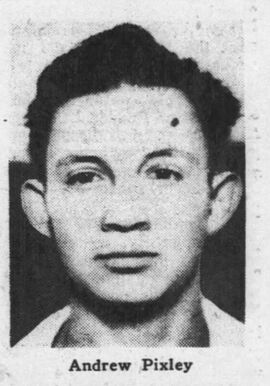 Andrew Pixley (1943-1965) Andrew Pixley (1943-1965) Pixley was convicted of murder and sentenced to death in February, 1965. He was tried only for the murder of Deborah McAuliffe, but he admitted to the slaying of her sister Cynthia. During his three-day trial he laughed openly, and Robert McAuliffe shouted, "Laugh some more you animal." The parents described finding both girls nude and one of them missing her nose, leading to the belief Pixley might have bit it off, and had cannibalized the bodies. Dr. William Karn, Jr. the medical director of the Wyoming State Hospital, who had examined Pixley for a month to determine if he was sane, said that “it meant a lot more to Pixley to kill the girls while they were awake, rather than while they were sleeping." McAuliffe so enraged he tried to attack Pixley during this part of the testimony. Karn described Pixley as a man who hated society. “A sociopath is sick in getting along with the outside world. He hates the human race, himself included". The psychiatrist described Pixley as “one of the sickest we’ve ever seen sociopathically”. He said chances to rehabilitate Pixley were "absolutely nil". 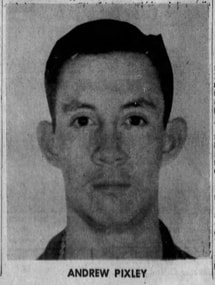 Andrew Pixley c.1965 Andrew Pixley c.1965 Pixley spent 11 months on death row, and expressed a desire to die. He got his wish on December 10, 1965 when he was strapped to a chair in the gas chamber. He laughed when the execution date was announced. He occupied the same cell as Henry Ruhl who was convicted in 1944 of killing Matt Katmo, a Cheyenne war worker. Pixley's was the first execution in 20 years. He also took the longest time to die than any other executed person in the Wyoming gas chamber. It took him seven minutes to expire. During his incarceration, Pixley had tried to carve the faces of his two victims in the wall of the cell. In November, 1965 Pixley's mother Benita Pixley and his stepfather wrote to the governor for clemency, but it was not granted. His last visitors were his step-father and his sister Agapita "Aggie" Owens. Neither one of them attended the execution. He willed his eyes to an eye bank at the University of Colorado's Medical School, and they were removed right after his death. His burial details remained unknown. 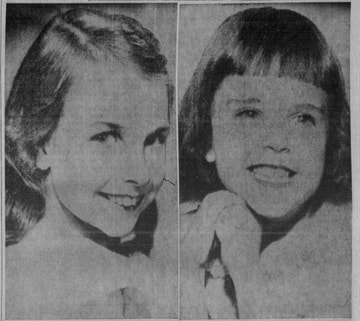 Debbie and Cindy McAuliffe c.1960s Debbie and Cindy McAuliffe c.1960s Debbie and Cindy McAuliffe were buried together in a single casket, and interred in Queen of Heaven Catholic Cemetery in Chicago, Illinois. Their parents later filed suit against the Wort Hotel in order to pay for the surviving child's psychiatric treatment. The McAuliffes divorced, and the judge remarried and had a son. Robert McAuliffe died in 1998, and Betty McAuliffe in 2010. Their youngest daughter Susan married and had five children. Employees of the prison claim that the spirit of Andrew Pixley still roams the prison. Many refuse to go anywhere near the his cell, believing the picture of the young man that hangs over his bunk watches them, claiming his cold, dead shark eyes follows whoever passes by. Others have claimed to hear his voice from beyond the grave confessing his crime as he laughs. Other witnesses have heard the sounds of young girls crying coming from the gas chamber. Another spirit that is seen is that of a ghost cat. This black cat was executed in the gas chamber as a “test run” to make sure the chamber had no leaks before Pixley’s sentence was carried out. There are sightings of other ghosts. The Wort Hotel where the murder was committed is also said to be haunted, some say by the two girls. The hotel burned down and was rebuilt, however the rooms that were built in the original spot where the murder room was situated, claim that these rooms have the most maintenance problems. The hotel is said to also be haunted by a one time maintenance engineer named Bob Tomingas who worked there in 1950. He was known for fixing the impossible. Current maintenance personnel believe he helps out when something needs fixing, since he knew the location of wiring, pipes, valves and all the secrets of the hotel after working there for 45 years. Bob died in 1999. Source - Murderpedia
0 Comments
Your comment will be posted after it is approved.
Leave a Reply. |
Stranger Than Fiction StoriesM.P. PellicerAuthor, Narrator and Producer Archives
July 2024
Categories
All
|
Stories of the Supernatural
- Stories of the Supernatural
- Miami Ghost Chronicles
- M.P. Pellicer | Author
- Stranger Than Fiction Stories
- Eerie News
- Supernatural Storytime
-
Astrology Today
- Tarot
- Horoscope
- Zodiac
-
Haunted Places
- Animal Hauntings
- Belleview Biltmore Hotel
- Bobby Mackey's Honky Tonk
- Brookdale Lodge
- Chacachacare Island
- Coral Castle
- Drayton Hall Plantation
- Jonathan Dickinson State Park
- Kreischer Mansion
- Miami Biltmore Hotel
- Miami Forgotten Properties
- Myrtles Plantation
- Pinewood Cemetery
- Rolling Hills Asylum
- St. Ann's Retreat
- Stranahan Cromartie House
- The Devil Tree
- Trans-Allegheny Lunatic Asylum
- West Virginia Penitentiary
- Paranormal Podcasts
"When misguided public opinion honors what is despicable and despises what is honorable, punishes virtue and rewards vice, encourages what is harmful and discourages what is useful, applauds falsehood and smothers truth under indifference or insult, a nation turns its back on progress and can be restored only by the terrible lessons of catastrophe."
- Frederic Bastiat
- Frederic Bastiat

Copyright © 2009-2024 Eleventh Hour LLC. All Rights Reserved ®
DISCLAIMER
DISCLAIMER
 RSS Feed
RSS Feed





